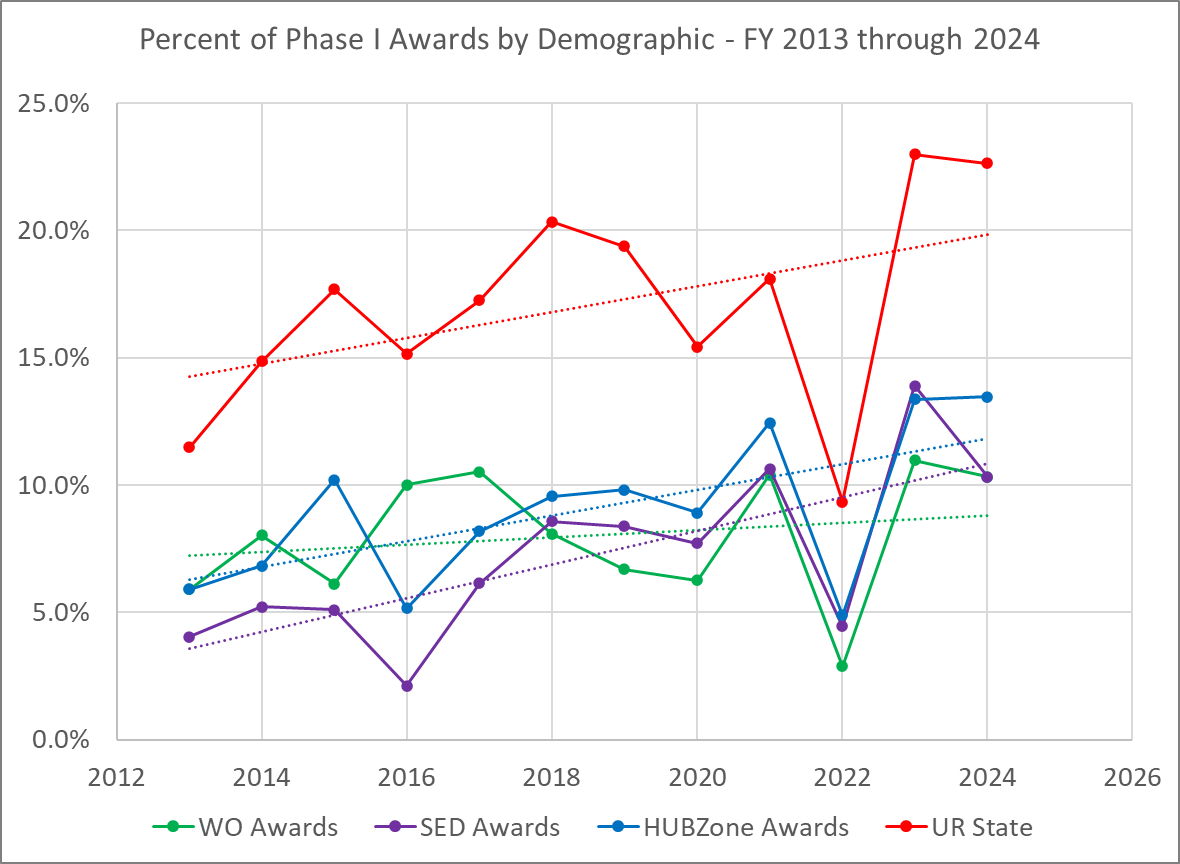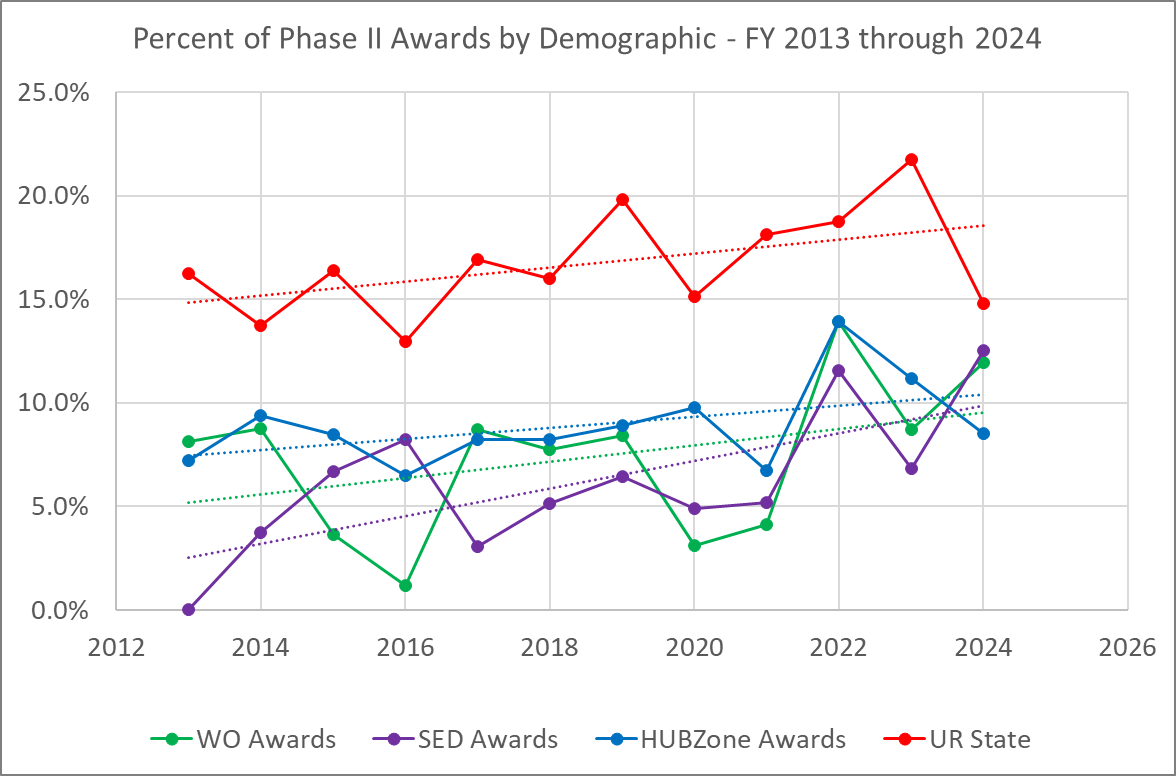Fostering Diverse Participation in Innovation

The Federal SBIR/STTR programs goals include fostering and encouraging participation in innovation and entrepreneurship by women and socially or economically disadvantaged persons. In order to advance this goal, Department of Energy SBIR/STTR Programs leverages the Office of Science’s (SC) Office of Scientific Workforce Diversity, Equity, and Inclusion (SW-DEI) recommended organizational best practices for promoting diversity, equity, and inclusion (DEI) in SC’s business practices for awarding and managing competitive research and to uphold SC’s DEI Statement of Commitment.
DEI is one cornerstone to effectively advancing the U.S. research and scientific innovation enterprise. Effective stewardship and promotion of diverse and inclusive research environments and workplaces that value and celebrate a diversity of people, ideas, cultures, and educational backgrounds is foundational to delivering on the SC mission.
Outreach
We are always interested in opportunities to heighten awareness of our program to diverse audiences and welcome applications from under-represented groups. Feel free to reach out to Eileen Chant with outreach requests.
Diversity, Equity and Inclusion at DOE SBIR/STTR are Critical to our Success
The Department of Energy’s Office of SBIR/STTR Programs seeks to foster increased diversity in its applicant and awardee pools. We are always interested in opportunities to heighten awareness of our program to diverse audiences and welcome applications from under-represented groups.
Who are the under-represented groups?
Our program currently tracks the following under-represented groups:
Women-Owned Small Businesses (WOSB) [more]
A women-owned small business is one that is at least 51 percent directly and unconditionally owned and controlled by one or more women who are U.S. citizens (born or naturalized) or permanent residents.Socially and Economically Disadvantaged Small Businesses (SEDSB) [more]
This designation is often confusing to applicants. A socially and economically disadvantaged small business is one that is at least 51 percent unconditionally owned and controlled by one or more individuals who are United States citizens (born or naturalized) or permanent residents that are both socially and economically disadvantaged.
A socially disadvantaged individual belongs to one or more of the following:
- Black Americans;
- Hispanic Americans;
- Native Americans (Alaska Natives, Native Hawaiians, or enrolled members of a Federally or State recognized Indian Tribe);
- Asian Pacific Americans (persons with origins from Burma, Thailand, Malaysia, Indonesia, Singapore, Brunei, Japan, China (including Hong Kong), Taiwan, Laos, Cambodia (Kampuchea), Vietnam, Korea, The Philippines, U.S. Trust Territory of the Pacific Islands (Republic of Palau), Republic of the Marshall Islands, Federated States of Micronesia, the Commonwealth of the Northern Mariana Islands, Guam, Samoa, Macao, Fiji, Tonga, Kiribati, Tuvalu, or Nauru); or
- Subcontinent Asian Americans (persons with origins from India, Pakistan, Bangladesh, Sri Lanka, Bhutan, the Maldives Islands or Nepal)
.
An economically disadvantaged individual must have:
- a net worth less than $850,000 (not including his or her primary residence and the value of the applicant/Participant firm),
- an average adjusted gross income of $400,000 or less for the preceding three years, and
- the fair market value of all his or her assets (including his or her primary residence and the value of the applicant/Participant firm) does not exceed $6.5 million. (Please review 13 CFR 124.103 and 104 for more information and for exclusions from the threshold amounts.)
Please visit CFR 124.103 and CFR.124.104 for more information
Historically Underutilized Business Zones (HUBZones) [more]
Small Business Applicants can review the full requirements in CFR 126.104 and additionally use the Small Business Administration’s HUBZone map to identify whether they qualify as a HUBZone business
Small Businesses in Under-represented States [more]

| DOE SBIR/STTR under-represented states | ||
|---|---|---|
|
Alabama |
Kansas |
New Jersey |
|
Alaska |
Louisiana |
North Carolina |
|
Arkansas |
Maine |
Oregon |
|
Washington D.C. |
Michigan |
Puerto Rico* |
|
Florida |
Minnesota |
Texas |
|
Georgia |
Mississippi |
West Virginia |
|
Idaho |
Missouri |
Wisconsin |
|
Indiana |
Nebraska |
|
|
Iowa |
Nevada |
|
Ownership demographics are not the whole diversity story. Aspects other than ownership are essential to improving the diversity of the U.S. Science, Technology, Engineering and Mathematics (STEM) research and development workforce including, but not limited to:
- The composition of the project team and partnering institutions
- The research environment—cultivating respectful, professional and accessible environments
- Partnering with underrepresented institutions and/or underserved communities
DOE SBIR/STTR is working to track and improve upon all critical aspects of diversity in our Programs. The National Science Foundations’ National Center for Science and Engineering Statistics contains datasets such as Women, Minorities, and Persons with Disabilities in Science and Engineering, which can be useful to understand STEM participation rates for certain underrepresented groups.
What are the participation rates for tracked under-represented groups?
Our office tracks the applicant and award demographics and informs program stakeholders to raise awareness. For the period 2013-2022, our application and award rates have increased for all under-represented groups as shown in the charts below. Our analysis of industries which participate in the DOE SBIR/STTR program using 2017 census data[1]predict that the women ownership rate for these industries is approximately 17%, and the SED ownership rate is approximately 18%. Under-represented ownership rates for small businesses participating in DOE SBIR are likely lower as the industry groups analyzed include businesses conducting R&D in the life sciences, which is a very small portion of DOE SBIR funded topics. Comparison of these values with the figures below suggest that the Phase I participation rates in these groups should be higher in order to reflect the demographics of the industry. Phase II participation rates have a larger gap.
DOE SBIR/STTR Phase I under-represented groups’ award rates as % of total awards with regression-based trend lines

DOE SBIR/STTR Phase II under-represented groups’ award rates as % of total awards with regression-based trend lines

What are we doing to advance diversity?
The Office of Scientific Workforce Diversity, Equity, and Inclusion within the Office of Science is leading efforts to both examine and improve practices to advance diversity. The Office of SBIR/STTR programs has created two programs with a specific focus on broadening participation:
- Our Phase 0 application assistance program (free of charge) provides first-time applicants with one-on-one coaching with Phase I application experts.
- Our new Diversity Supplement program provides Phase II awardees an opportunity to diversify their workforce and provide STEM students with exposure to entrepreneurial careers.
- Improving accessibility to the application process through Q&A webinars and revamped application guidance
In addition, we continue to engage with under-represented communities to encourage participation in the SBIR/STTR programs. Contact us to schedule an outreach event for your community!
[1] Census.gov

